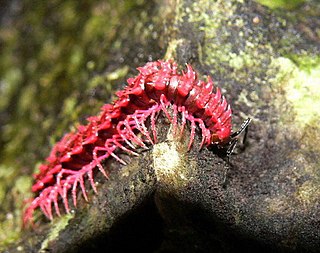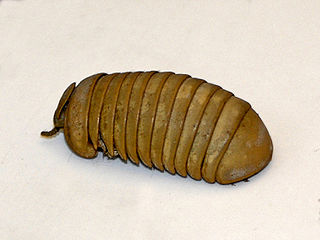
Desmoxytes, whose species are commonly known as the dragon millipedes, is a genus of millipedes of the family Paradoxosomatidae found in Southeast Asia. The genus was described by Ralph Vary Chamberlin in 1923, and reviewed by Sergei Golovatch and Henrik Enghoff in 1994. At least 18 species are known from to Malaysia, Myanmar, and Thailand. One species, D. planata, has also been observed in Sri Lanka, the Andaman Islands, Seychelles, Java, Great Coco Island, and Fiji; however, this species has expanded its range by being transported through human activity. Several species have only recently been discovered, and some have yet to be officially described.

Polydesmida is the largest order of millipedes, containing approximately 3,500 species, including all the millipedes reported to produce hydrogen cyanide (HCN). Polydesmids grow and develop through a series of moults, adding segments until they reach a fixed number in the adult stage, which is usually the same for a given sex in a given species, at which point the moulting and the addition of segments and legs stop. This mode of development, known as teloanamorphosis, distinguishes this order from most other orders of millipedes, which usually continue to moult as adults, developing through either euanamorphosis or hemianamorphosis.
Hylomus is a genus of millipede of the family Paradoxosomatidae found in southeast Asia.

Richard Lawrence Hoffman was an American zoologist known as an international expert on millipedes, and a leading authority on the natural history of Virginia and the Appalachian Mountains. He was a biology professor at Virginia's Radford College for almost thirty years, and curator of invertebrates at the Virginia Museum of Natural History for another twenty years. He co-founded the Virginia Natural History Society, described over 400 species of millipedes, and produced more than 480 scientific publications. He is commemorated in the scientific and/or common names of over 30 animal species, including the valley and ridge salamander and Hoffman's dwarf centipede.

Chordeumatida is a large order of millipedes containing some 1200 species with a nearly worldwide distribution. Also known as sausage millipedes, they grow and develop through a series of moults, adding segments until they reach a fixed number in the adult stage, which is usually the same for a given sex in a given species, at which point the moulting and the addition of segments and legs stop. This mode of development, known as teloanamorphosis, distinguishes this order from most other orders of millipedes, which usually continue to moult as adults, developing through either euanamorphosis or hemianamorphosis.

Orthomorpha coarctata, the long-flange millipede, is a widely introduced species of Polydesmidan millipede of the family Paradoxosomatidae. It is presumed native to Southeast Asia but due to transport by humans occurs in tropical and sub-tropical areas throughout the world, including the Hawaiian Islands, the West Indies, Gulf Coast of North America, and the Galápagos Islands.

Casimir Albrecht Willem Jeekel (1922–2010) was a Dutch myriapodologist and entomologist known for his major contributions to the taxonomy of millipedes. His 1971 monograph Nomenclator Generum et Familiarum Diplopodorum is credited as launching the "modern era" of millipede taxonomy, and has been considered the "most important single work ever published on the Diplopoda". He served as director of the Zoological Museum Amsterdam, and authored over 150 works on the taxonomy of millipedes and other myriapods.

Ammodesmidae is a family of small millipedes endemic to Africa, containing seven species in two genera. Ammodesmids range from 1.4 to 5.0 mm long with 18 or 19 body segments in both sexes, and are capable of rolling into a tight sphere.
Hylomus rhinoceros is an aposematic species of dragon millipede in the family Paradoxosomatidae. It is only known from Champasak and Sekong Provinces in southern Laos.
Hylomus rhinoparvus is a species of dragon millipede in the family Paradoxosomatidae. It is only known from Houaphanh Province of northeastern Laos.

Chamberlinius is a genus of flat-backed millipedes in the family Paradoxosomatidae. There are five species; 3 of which occur only Taiwan, one only in the Ryukyu Islands of southeast Japan, and one occurring in both areas. Individuals are 25–37 mm (0.98–1.46 in) long and up to 5.5 mm wide, colored in pale yellow to brown, sometimes with dark brown markings on the anterior portion of body segments.

Zephronia is a genus of giant pill millipedes in the family Zephroniidae. This genus includes 47 species distributed throughout N. India, Myanmar, Thailand, Malayan Peninsula, Java, Sumatra and Borneo.

Boreohesperus is a genus of paradoxosomatid millipedes containing six species native to Western Australia. The name refers to the northwestern distribution in Australia, deriving from Boreas, Greek god of the North, and hesperus, Latin for "west".
Anoplodesmus sabulosus, is a species of millipedes in the family Paradoxosomatidae. It is endemic to Sri Lanka, which was first documented from Kandy.

Desmoxytes planata, is a species of millipedes in the family Paradoxosomatidae. It is a pantropical species with a vast distribution due to human interference in transportation. It is native to Andaman Islands and introduced to Thailand, the Seychelles, Java, Sri Lanka, Fiji and probably in Malay Peninsula.

Anoplodesmus is a genus of millipedes. It is one of the most species rich genera in the family Paradoxosomatidae, with over 40 described species distributed from India and Nepal to China and Southeast Asia, as well as the Mascarene Islands and Fiji.
Tonkinosoma tiani, is a species of millipede belonging to the family Paradoxosomatidae. It is found from caves in southern China.

Desmoxytes cervina, is a species of millipede in the family Paradoxosomatidae. It is known from Myanmar and Thailand.

Desmoxytes golovatchi, is a species of millipede in the family Paradoxosomatidae, that can be found in Thailand.

Stenoniodes, commonly known as the Borneo tractor millipede, is a genus of millipede in the family Platyrhacidae. It contains six species, five of which occur on Borneo and one on Sibutu Island. Its common name originates from the likeness of its 20-segmented body to the tread of a tractor's tire.
















